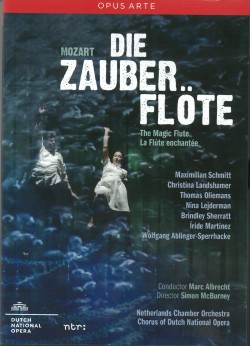 Mozart – Die Zauberflöte
Mozart – Die Zauberflöte
Schmitt; Landshamer; Oliemans; Lejderman; Dutch National Opera; Netherlands Chamber Orchestra;
Marc Albrecht
Opus Arte OA 1122 D
Die Zauberflöte is not an easy opera to pull off, as it needs a director who is able to present the farcical elements such as the serpent that threatens Tamino at the beginning of the opera and the antics of Papageno, but is also in tune with the sense of ritual needed for the scenes with Sarastro and his initiates. This production, directed by Simon McBurney, is on the whole quite successful. I did not like everything: I could have done without the crowds of actors running on the stage, waving pieces of paper and pretending to be birds. I thought the initiates in their suits and with their neckties looked too much like the personnel of an insurance company. I don’t understand why the Queen of the Night was in a wheelchair or why the Three Spirits (very well sung by three boy sopranos) were made to look like wizened old men or why the Speaker was so grim and unsympathetic.
But there are marvellous moments. Pamina (the wonderful Christina Landshamer) and Papageno (Thomas Oliemans, a fine actor and a fine singer) set up a great relationship in their first scene together which then leads to a beautiful performance of the duet: Bei Männer welche Liebe fühlen. In several scenes Tamino plays his (magic) flute. Clearly unless the tenor is also a flutist he will mime these scenes while the flute is played by an orchestral musician. McBurney has taken the conventional presentation a stage further by either having the flutist join Tamino on stage or moving Tamino down into the orchestra pit. This is an inventive production set on a bare stage without any emphasis on theatrical illusion. Michael Levine’s set designs complement the production very well. The whole opera is well sung and there is no weak link in the cast.



